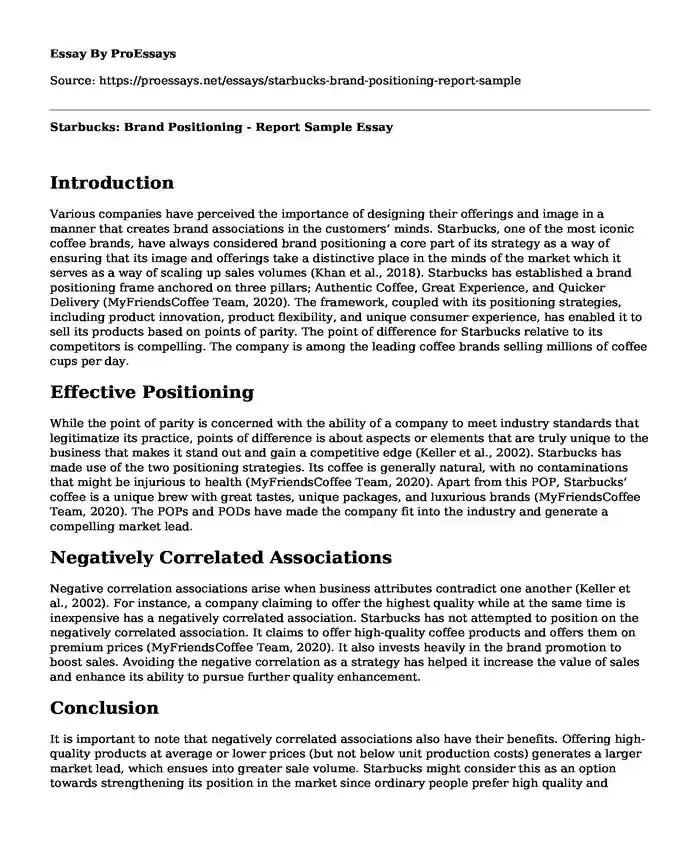Introduction
Various companies have perceived the importance of designing their offerings and image in a manner that creates brand associations in the customers’ minds. Starbucks, one of the most iconic coffee brands, have always considered brand positioning a core part of its strategy as a way of ensuring that its image and offerings take a distinctive place in the minds of the market which it serves as a way of scaling up sales volumes (Khan et al., 2018). Starbucks has established a brand positioning frame anchored on three pillars; Authentic Coffee, Great Experience, and Quicker Delivery (MyFriendsCoffee Team, 2020). The framework, coupled with its positioning strategies, including product innovation, product flexibility, and unique consumer experience, has enabled it to sell its products based on points of parity. The point of difference for Starbucks relative to its competitors is compelling. The company is among the leading coffee brands selling millions of coffee cups per day.
Effective Positioning
While the point of parity is concerned with the ability of a company to meet industry standards that legitimatize its practice, points of difference is about aspects or elements that are truly unique to the business that makes it stand out and gain a competitive edge (Keller et al., 2002). Starbucks has made use of the two positioning strategies. Its coffee is generally natural, with no contaminations that might be injurious to health (MyFriendsCoffee Team, 2020). Apart from this POP, Starbucks’ coffee is a unique brew with great tastes, unique packages, and luxurious brands (MyFriendsCoffee Team, 2020). The POPs and PODs have made the company fit into the industry and generate a compelling market lead.
Negatively Correlated Associations
Negative correlation associations arise when business attributes contradict one another (Keller et al., 2002). For instance, a company claiming to offer the highest quality while at the same time is inexpensive has a negatively correlated association. Starbucks has not attempted to position on the negatively correlated association. It claims to offer high-quality coffee products and offers them on premium prices (MyFriendsCoffee Team, 2020). It also invests heavily in the brand promotion to boost sales. Avoiding the negative correlation as a strategy has helped it increase the value of sales and enhance its ability to pursue further quality enhancement.
Conclusion
It is important to note that negatively correlated associations also have their benefits. Offering high-quality products at average or lower prices (but not below unit production costs) generates a larger market lead, which ensues into greater sale volume. Starbucks might consider this as an option towards strengthening its position in the market since ordinary people prefer high quality and affordable products. However, it might limit the ability of the company to stay innovative but instead shift their efforts to marketing (Mitchell, 2002). Other brand positioning strategies that it might consider include market segmentation, social media innovations, partnerships, and acquisitions.
References
Keller, K. L., Sternthal, B., & Tybout, A. (2002). Three questions you need to ask about your brand. Harvard business review, 80(9), 80-89.
https://hbr.org/2002/09/three-questions-you-need-to-ask-about-your-brand
Khan, S. K. B. N. Z., Yusop, Y. B. M., & Baharudin, F. B. W. (2018). Starbucks Market Segmentation and Targeting. https://www.ijbmi.org/papers/Vol(7)5/Version-1/F0705014445.pdf
Mitchell, C. (2002). Selling the brand inside. Harvard business review, 80(1), 99-101. https://europepmc.org/article/med/12964471
MyFriendsCoffee Team. (2020, April 26). Why is Starbucks so popular? MyFriendsCoffee.
https://myfriendscoffee.com/why-is-starbucks-so-popular/.
Cite this page
Starbucks: Brand Positioning - Report Sample. (2023, Nov 25). Retrieved from https://proessays.net/essays/starbucks-brand-positioning-report-sample
If you are the original author of this essay and no longer wish to have it published on the ProEssays website, please click below to request its removal:
- Personal Leadership Training Plans: Knowledge
- Why Do Some Mergers and Acquisitions Fail? - Essay Sample
- Essay Sample on Nike: From US Giant to Global Controversy
- Essay Example on Ethical Considerations: An Essential Part of Business Success
- Paper Example on Company Analysis: Wendy's Customers, Collaborators, Competitors
- Essay Example on Leadership: Indra Nooyi's Role in PepsiCo's Success
- Essay Sample on Everest Team Decision-Making: Enhancing Project Accomplishment







